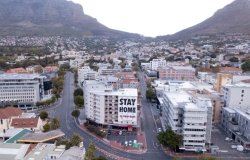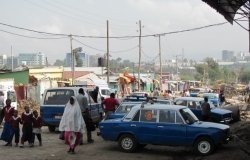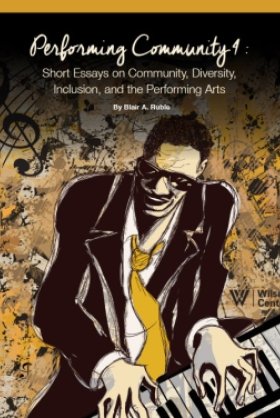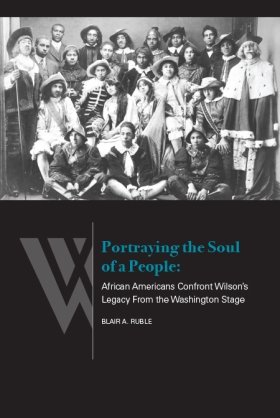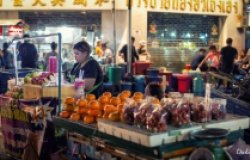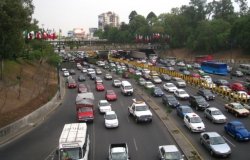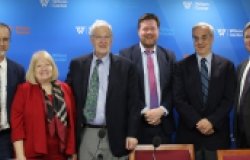Migration, Urbanization, and Social Adjustment
Presented February 8-9, 1999, at the Woodrow Wilson Center for the Comparative Urban Studies Project's Research Working Group on Urbanization, Population, the Environment, and Security funded by the U.S. Agency for International Development. These policy briefs do not represent an official position of the Woodrow Wilson International Center for Scholars or the U.S. Agency for International Development. Opinions expressed are solely those of the authors.
Migration is the demographic process that links rural to urban areas, generating or spurring the growth of cities. The resultant urbanization is linked to a variety of policy issues, spanning demographic, economic, and environmental concerns. Growing cities are often seen as the agents of environmental degradation. Urbanization can place stress on the land through sprawl; coincident industrial development may threaten air and water quality. In the eyes of many observers, rapid urbanization is also linked to problems of unemployment and the social adaptation of migrants in their new urban setting. Cities advertise society's inequalities in income, housing, and other social resources, whether these problems are new or just newly manifest in urban settings.
Most of the migration conventionally liked to these urban issues was seen as following a conventional pattern. In this policy brief I raise some issues about the nature of contemporary, migratory behavior, both for our understanding of processes of population redistribution directly, and for understanding some of the implications of that redistribution. Contemporary research is sketching the contours of this migratory behavior and the social adjustment that accompanies it. New research is beginning to shed light on the rate of migrant adaptation, on the connection between origin and destination communities through remittances, and the demographic structure and dynamics of refugee movements.
The New Migration?
Is there an evolving pattern of migratory behavior and composition that warrants a reconsideration of our prevailing models? The first round of migration models presumed that movement -- permanent movement -- was induced by prevailing wage differentials and economic opportunities. Thus one observed transatlantic migration from Old to New World as part of a permanent population redistribution within and across generations. To be sure the emptying of the countryside in the 19th century made London, Paris and New York into huge urban agglomerations.
The conventional push-pull model was eventually placed by one a bit more subtle, one that took into account the inefficiencies of markets in many developing settings. Rather than producing adjustment and equilibrium, migration spurred the growth of the informal sector as rural origin persons settled, at least temporarily, for wages and employment chances below the hoped-for formal sector offering. Thinking about migration in high income settings also shifted. New thinking began to take into account more of the non-pecuniary determinants of migration: climate; social composition of origin and destination; access to amenities. Such thinking made it possible to understand certain paradoxes such as the movement away from some of the economic regions with the highest hourly wages (the U.S. manufacturing belt) and toward other, lower wage but more amenity-rich locales.
During much of this time, policymaking often held a series of assumption about the process of migration and urban growth. A common observation was that urbanization was rapid and driven by rural-urban migration. Consistent with the dual economy (Harris-Todaro) model, the perception was that migrants had a difficult time adjusting in the urban area and were often unemployed or underemployed. Percolating through the time periods as well, was an old demographic adage about the composition of the migrant stream: that it was predominantly, unmarried young males. Concurrently, rapid urban growth fueled concern about denigration of the surrounding physical environment.
These models, trends, and to some degree social realities were consequential for policy. Rural-urban migration was seen as a problem. Urbanization was seen as too rapid, and efforts were considered to slow it or shift the balance of growth to other areas. Notable for instance, was China's policy of encouraging development in mid-size cities during the 1980s. Growth pole or satellite town developments were other offered responses. Of course, an alternative line of thinking evolved, arguing the public sector was the cause of some of the urban ills, with its disproportionate investment in (selective) cities and resultant urban bias.
Is our stock of knowledge, our set of models, adequate to understand population movement and redistribution today, especially in contemporary developing economies? Some rethinking is in order. Two major changes have come to many systems of population distribution in the last decade or two: (1) the revolution in technology of transportation and communication; and (2) the restructuring of national economies to allow more market activity. Both of these changes have received considerable attention elsewhere. They have been discussed in the case of migration, but it is worth tracing through how they reshape the nature and composition of migratory flows.
The changes in the technology of communication and transportation have made it easier for migrants to stay in touch with their origin communities. This is more than maintaining simple social ties. The tightness and stability of these connections can reinforce the implicit contracts that generate sharing of resources across locations. Most notably these are remittances. Despite the high level of interest in remittances, it remains to be clearly documented that these technological developments help maintain a continuous flow. There are related influences. The technologies of communication help impart knowledge of job market opportunities within and across national borders.
The "New Migration" includes circulation. Migrants oscillate between origin and destination. From various parts of the wold circulatory migration patterns have been identified. Often these circulatory movements are timed with the agricultural season. In West Africa, Thailand, and Mexico, for instance, individuals remain in the origin region from planting through tending to harvest, and then depart for the cities (and to the United States for Mexicans) during the off season. Limited evidence suggests that the movements are repeated, but not necessarily every season. Landing a "good" job in one year may lead to a longer stay in the destination. This is just another way of managing the informal-formal sector issue.
It may be the case also that the ability to store earnings (in banks) and move funds geographically is contributing to the new migration. One marker of economic development is the improvement in financial infrastructures. If one can move money across international borders, then the ease with which one can be a new migrant and remain a connected member of the origin community and household rises. While there have been efforts to account for the value of international flows of remittances, there is little understanding of whether improvements in financial infrastructure help generate and support migration in the first place.
Data coming from various field sites suggest that the conventional demographic profile of the rural-urban migrant may be shifting as well. Migrants are still young. While many are male and single, there seems to be an increasing fraction of migrants who are female and a larger pool of family migrants. The work on Mexican migration to the United States finds substantial fractions of females in the migratory flow, fractions that increase with time. Our own work in Ghana challenges the notion that migrants are detached from families in the destination. What we need to know more about is the timing of the movements of family members. It is probably the case that frontier or first-wave migration is predominantly young single males, but how exactly the stream is altered after that is not well known.
The second major impetus for the New Migration is economic restructuring. Many countries have reoriented their economies in the direction of more free market activity. To argue that this trend is universal or that the movement is to an unfettered marketplace would be silly. Nevertheless, in several important ways the shift is on, and population distribution is a manifest component of this shift. The most notable case is China. Where once all residence was controlled by registration permit (or hukou), the years since market reform have enabled individuals to relocate to areas of economic opportunity. This has created a huge pool --a "floating population" in the tens of millions of persons -- living apart from their place of formal registration. While often referred to as "temporary" migrants, the length of residence in destination can now approach several years. Considerable controversy swirled about the motivations of these temporary migrants (including the claim that women were moving to avoid the structures of the one-child family planning policy), but the migration seems to be economically driven.
This kind movement, a migration problem, in the wake of the relaxation of strictures on economic activity and hocusing has been seen in other settings as well. Viet Nam is now going through a process similar to that experienced by China. While residence registration was never as strictly controlled as in China, the economic restructuring (Doi Moi) has generated internal migration. In Ethiopia the fall of the Derg and its more authoritarian and socialist ways ushered in a period of economic relaxation. This loosening not only lets people move to new locations (often back to older villages they were forced to abandon), but also generates differential economic growth by region, producing labor force opportunities to which workers respond.
Even in economies without government restrictions on residence and movement, there have been patterns of population movement that are similar in many respects. The undocumented movement of the Mexican origin population to the United States and parallel movement of former colonial populations to high-income economies of Europe have created similar floating populations, each with its own stamp for the particular migratory flow and condition of reception in the host society. Again, "temporary" migration is sometime sustained by circulation, at some risk of being caught, and rarely is temporary or guest-worker migration, in fact, temporary. Circulation may be substituting for return.
The evidence from Ghana indicates that the country's pursuit of structural adjustment has resulted in substantial shifts in regional activity, even as the overall growth of economic activity outpaces other sub-Saharan African nations. In the age-old way this induced movement, directed differentially to some urban areas.
Migration's Consequences
Migration from rural to urban areas generates a series of concerns, including worries about environmental stress and social adaptation of the migrants themselves. Since migration feeds urbanization, and since urban growth is associated with industrial development (pollution) and land consumption, migration is often held culpable in environmental degradation. Although the link is there, it is not clear how strong that link is.
Direct public policies regarding environmental conditions, the underlying infrastructure for transportation, and the national level of income may have much more to say about the amount of insult visited upon the environment than the amount of rural-urban migration per se. As income rises, so does consumption of consumer goods, transportation, and land. These all can lead to more pollution and sprawl in any country. But as the level of income rises so does the demand for a cleaner local environment, and so there is an element of feedback in all of this.
There is another demographic component of the comparison. It is useful to remember that a large fraction, maybe nearly half, of urban growth is generated just by natural increase of the urban population. Thus, stemming urbanward migration will not stem urban growth. This reminds us that in the absence of migration but in the presence of positive population growth rates, there is more "population pressure" in both urban and rural areas. Migration may be more implicated than its true demographic contribution would warrant. Not that theincreasingly intensive use of rural and quasi-rural areas can lead to soil erosion, deforestation, and the like. This might lead one to call for stronger emphasis on fertility reduction measures, but the demographic community seems somewhat agnostic about the empirical connection between population growth and environmental conditions.
The other major area of concern in urbanward migration is that of the absorption of migrants into the host community. Migrants have always generated apprehension about their ability to mix into the receiving society. Migrants are seen as adapting slowly or not at all. Empirical evidence runs counter to this.
In many studies of immigrant adaptation in the United States, the first generation exhibits substantial differences from the native population along socioeconomic lines: income, education, language ability, etc. By the second generation, however, differences are narrowed considerably. Even if one does not adjust for background characteristics, the second generation gap is modest compared to the first generation gap. But when one does adjust for the (usually lower) level of resources for members of the second generation, the gap narrows even more. Work with nationally representative longitudinal data on immigrant achievement in school illustrates the point. Once we control for family characteristics (parental presence and supervision, socioeconomic status) and starting point in school, the trajectory of subsequent school achievement does not differ for immigrant children.
Interestingly we find a closing of the gap among migrants to Kumasi, Ghana. The first generation has lower status than members of the indigenous group in the same residential area, but members of the second generation show very little shortfall at all. In a parallel vein we find a process of occupational adaptation that differentiates the first generation more than the second. Market adjustment in China generated a huge flow of persons, both officially recognized and documented and "temporary" or undocumented. Despite the observation of migrants on streetcorners and under bridges (latter day hiring halls), the evidence again is that migrants are driven by economic considerations. The claim was made in China that female migrants to the city were motivated by a desire to avoid the family planning policies enforced in their origin community. In fact such rural-urban migrants were found to have birth rates no higher than urban natives of the same educational level and age. Here again, migrants were not out of line with expectation; they had come for jobs and merged into the urban fabric.
Concluding Policy Considerations
There are several policy implications of this redistribution, but I will concentrate on just three points.
1. Migration is Only Part of the Picture
As we have discussed migration accounts for roughly half of urban growth in most developing country cities. Most demographic analyses confirm that overall urban growth rates are closely ties to national population growth rates. Declining fertility rates overall will help reduce urban population pressure. High income economies experience the mirror image effect. Most of these nations have very low rates of natural increase. Consequently international migration contributes a substantial fraction of total year-to-year national population growth. The lesson is that it is important to have the comparative framework clear when making assertions about the impact of migration.
2. Informal Migration is a Broad-based phenomenon
Undocumented, circulate, and temporary migration is now a world-wide phenomenon. It exists as internal migration in some restructuring economies (such as in China) but also appears as international migrant flows in other settings (such as Mexican origin migration to the United States). It is useful for policy-makers to think about the parallels in these movements, rather than concentrate only on the differences.
3. Recognize Migratory Realities.
It is time for policy-makers to respond to migration rather than try to control migration. This is the case for internal migration and displacements. The opening of markets within and between countries will produce further internal and international redistribution. For voluntary movement, this recommendation means that efforts should go into adjustment efforts for migrants. Efforts might be made to improve access to information about health care, get migrant children into health and educational facilities, and provide language assistance as appropriate. For forced migrants the story is somewhat different. Here the migrants are outside their original location, often in a bounded settlement or camp. The policy need here is to realize that these refugee movements are often not temporary. This means a whole set of long-term services (health, family planning, productive work) must beprovided. For people displaced within national borders, sometimes without the assistance of international agencies, the relocation can be permanent.
Related Program

Urban Sustainability Laboratory
Since 1991, the Urban Sustainability Laboratory has advanced solutions to urban challenges—such as poverty, exclusion, insecurity, and environmental degradation—by promoting evidence-based research to support sustainable, equitable and peaceful cities. Read more

